Toyota in motorsport
Since its introduction to motorsport in the early 1970s, Toyota has been involved in a number of motorsport activities, most notably in Formula One, NASCAR, IndyCar, Champ Car, sports car racing and rallying. Currently, Toyota participates in Toyota Racing Series, Formula Nippon, Formula Three, NHRA, Grand Am, USAC, Super GT, NASCAR and the World Endurance Championship; although Toyota cars are still entered in rally competitions these are privateer entries and are not backed by the company themselves.
Rallying
Toyota's presence in motorsport can be traced back to the latter part of 1972, when Swedish driver, Ove Andersson, drove for Toyota during the RAC Rally of Great Britain. During the winter of 1972, Andersson formed Andersson Motorsport in his native country and began running a rallying program for Toyota. The move turned out to be an impractical one and three years after establishing his team, Andersson moved its base from Sweden to Brussels in Belgium. The team was renamed to Toyota Team Europe.
Toyota's first win in motorsport came at the 1975 1000 Lakes Rally in Finland, when Hannu Mikkola and his co-driver Atso Aho won the event in a Toyota Corolla. Three years later, the team moved to a new base in Cologne, in western Germany. It was not until the 1980s when Toyota began to gain continuous World Rally Championship success, especially in the long-distance African rallies, where Björn Waldegård and Juha Kankkunen were usually top of the time sheets. The team then set-up its all-purpose motorsport facility in Cologne three years later, which is still used today.
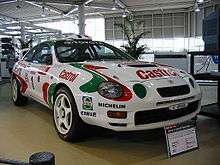
In the 1990 season, Carlos Sainz won the drivers' title, giving Toyota its first-ever world championship title in a four-wheel drive Toyota Celica, and repeated the feat two years later. In 1993, Toyota bought the team from Andersson and named it Toyota Motorsport GmbH. In the same year, Kankkunen won the world title and Toyota won the constructors' championship, becoming the first Japanese manufacturer to do so. This success was repeated a year later, but this time it was Frenchman Didier Auriol who clinched the drivers' world championship.
In 1995, Toyota were caught using illegal turbo restrictors at the Rally Catalunya and were given a 12-month ban by the FIA. FIA president Max Mosley called the illegal turbo restrictor "the most sophisticated device I've ever seen in 30 years of motor sports." Toyota and their drivers, Kankkunen, Auriol and Armin Schwarz, were also stripped of all points in the championships. Kankkunen had been in contention for the drivers' world title. Mosley stated that "there is no suggestion the drivers were aware of what was going on."[1]

Toyota returned to the WRC with a World Rally Car based on the Toyota Corolla. The Corolla WRC debuted at the 1997 Rally Finland, with Auriol finishing in eighth place and Marcus Grönholm retiring. In the 1998 season, Sainz came within two points of the world title, after his Corolla WRC suffered an engine failure only 500 metres from the finish of the final stage of the final rally in Great Britain. Toyota were within six points of the constructors' championship.
Toyota decided to quit running in the WRC at the end of the 1999 season, quoting that "all that can be achieved has been achieved." The team managed to secure the manufacturers' title in their last season, four points ahead of their nearest rival Subaru, while Auriol placed third in the drivers' championship, coming within ten points of the drivers' title, and Sainz fifth.
In March 2007, Toyota debuted its Super 2000 -category Corolla rally car, which will compete in the Australian Rally Championship.[2]
Toyota has announced that they will be competing in the 2017 World Rally Championship with the Toyota Yaris WRC World Rally Car.
CART IndyCar World Series/IRL IndyCar Series
Toyota raced in the CART IndyCar World Series from 1996 to 2002. Its early years in the series were marked by struggles. Toyota-powered cars, campaigned by the All American Racers and PPI Motorsports teams, languished at the back of the grid, slow and unreliable. Toyota didn't even lead a lap until Alex Barron led 12 laps at the Vancouver street circuit in September 1998.
Toyota started seeing its fortunes improve in 1999 as Scott Pruett took pole position at the final race of the season at the California Speedway. The next year, Juan Pablo Montoya gave Toyota its first-ever CART win at the Milwaukee Mile, the first of 5 races won by Toyota-powered cars that year. Toyota-powered cars won six races in 2001. In 2002, Toyota's final year in the championship, it turned things around completely from its bleak debut. Toyota won the Manufacturer's championship, 10 races, and Cristiano da Matta rode Toyota power to the driver's championship, with Bruno Junqueira, also Toyota-powered car, finished second.
Toyota moved to the IRL IndyCar Series in 2003 and provided factory support to former CART teams Team Penske and Target Chip Ganassi Racing as well as other teams. They were one of the top engines in their first year, winning the Indianapolis 500 with Gil de Ferran and the championship with Scott Dixon. However, 2004 and 2005 were not so kind and wins were few and far between. Following the 2005 IndyCar Series, Team Penske and Target Chip Ganassi Racing announced they would switch to Honda engines, leaving Toyota with no championship contenders. As a result of this and their intent to re-allocate resources for NASCAR, Toyota announced they would leave the IndyCar Series during the off-season. Toyota still remained in the IndyCar Series as only a sponsor for the Long Beach Grand Prix, from 2009 until present.
Le Mans and the World Endurance Championship
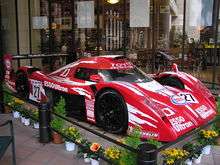
Toyota's 24 Hours of Le Mans efforts date back to the 1980s with Dome prepared Group C cars. Factory supported Toyota Team Tom's competed in World Sportscar Championship and Le Mans until 1994, with varying results. Toyota achieved 2nd place in the 1992 24 Hours of Le Mans.
Toyota started recruiting staff for their Le Mans efforts in 1997, with an aim to start a Formula One team. Toyota's efforts for a Le Mans car was the Toyota GT-One. Driver line-up included ex-Formula One drivers Martin Brundle, Thierry Boutsen and Ukyo Katayama. The 3.6-litre twin-turbo GT-Ones were beaten in 1998, but in 1999 they were the quickest cars in the field. However, they failed to achieve a victory after a tire failure late in the race. The GT-One held the lap record for the Circuit de la Sarthe up until 2006, however.
Toyota returned to the Le Mans 24 Hours and the FIA World Endurance Championship in 2012 with a petrol-electric hybrid car, the Toyota TS030 Hybrid.[3]
In 2016 they led the Le Mans 24 Hours for 23h55, until the car inexplicably stopped due to a mechanical failure, and Porsche overtook them for the win. The other Toyota went on to finish 2nd. The initial leading Toyote eventually finished the race, completing the final lap in 11m55, but was not classified, as it could not finish the final lap in 6 minutes as required by regulation 10.5.
NASCAR
Toyota races the Toyota Tundra in the NASCAR Camping World Truck Series and the Toyota Camry in the NASCAR Sprint Cup Series as well as the Xfinity Series.
Goody's Dash Series
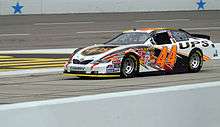
Toyota made its first move into the NASCAR ranks with the introduction of its V6-Celica Goody's Dash program in 2000. Robert Huffman helped make Toyota a legitimate contender for the series title by its second season while placing second in the championship in both 2001 and 2002. In 2003, Huffman broke through to become Toyota's first-ever NASCAR champion to win the series title.
Camping World Truck Series
BRG Motorsports, Kyle Busch Motorsports, Red Horse Racing, SS-Green Light Racing and ThorSport Racing currently run the Toyota Tundra in the Camping World Truck Series. Travis Kvapil gave Toyota its first win in a NASCAR national series, in the NASCAR Craftsman Truck Series, in the 2004 Line-X 200 at Michigan International Speedway in his Tundra sponsored by Line-X and owned by Bang! Racing.

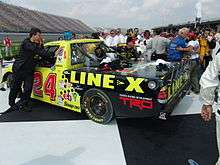
Todd Bodine became the first driver to give Toyota their first ever NASCAR championship by winning the NASCAR Craftsman Truck Series Title in 2006. Johnny Benson Jr. gave Toyota their second NASCAR championship in 2008. Several high-profile drivers such as Kimi Räikkönen and Nelson Piquet Jr. had tested or driven Toyota Trucks within the series.
Xfinity Series
Joe Gibbs Racing, RAB Racing, JGL Racing and TriStar Motorsports currently run Toyota Camrys in the Xfinity Series. Jason Leffler gave Toyota its first win in the series (then known as the Busch Series) in the Kroger 200 at O'Reilly Raceway Park on July 28, 2007, in his Camry sponsored by Great Clips and owned by Braun Racing.
Sprint Cup Series

BK Racing, Joe Gibbs Racing and Furniture Row Racing currently run Toyota Camrys in the Sprint Cup Series.
After success in the Craftsman Truck Series, Toyota moved to the then Busch Series (now Xfinity Series) and NEXTEL Cup Series (now the Sprint Cup Series) with the Toyota Camry for 2007. Two relatively new teams, Michael Waltrip Racing and Red Bull Racing Team, along with long-time Cup team Bill Davis Racing spearheaded the initial Toyota Cup program. Toyota struggled in its first season in Sprint Cup, harnessing only two poles in 36 races, and posting only one five top-5 and ten top-10 finishes across 7 Toyota teams. After the 2007 season, Toyota added 3-time champion Joe Gibbs Racing and affiliate Hall of Fame Racing to the Camry lineup. BAM Racing also joined Toyota Motorsports early in the 2008 season.
Kyle Busch gave Toyota its first NASCAR Sprint Cup Series win in the Kobalt Tools 500 at Atlanta Motor Speedway on March 9, 2008. Busch led a race-high 173 laps in his Snickers sponsored Camry, owned by Joe Gibbs Racing.[4] At the end of the 2008 season, Toyota had 10 victories and Denny Hamlin and Kyle Busch finished 8th and 10th respectively in the 2008 Chase for the Sprint Cup. In 2009, Toyota would continue its successful run with a further 10 victories, 4 each for star drivers Denny Hamlin and Kyle Busch along with surprise wins from MWR's David Reutimann and Red Bull's Brian Vickers. By this time Toyota had established itself as a regular winner in NASCAR's top series, but a championship still eluded them. Coming off back to back 10 win seasons Toyota was poised to challenge 4-time defending series champion Jimmie Johnson and the Chevrolet juggernaut for the crown. After a torrid start by Johnson with wins in 3 of the first 5 races, Joe Gibbs Racing driver Denny Hamlin emerged as a real threat to the dominant Hendrick Motorsports team. Hamlin would win a series high 8 races for Toyota during the 2010 campaign and hold the points lead going into the final race of the season before an untimely incident would cost him the title[5] 2011 would prove to be a slightly down year for Toyota as flagship team Joe Gibbs Racing struggled to find the speed they had shown the year before. The 2012 campaign was one of change for Toyota as they merged engine programs with Joe Gibbs Racing. To this point JGR had been building their Toyota motors in-house under Mark Cronquist while Toyota's TRD facility in California supplied Michael Waltrip's outfit.[6] The engine merger provided for more collaboration and shared resources among the top Toyota teams with all engines being produced by TRD in California. As a result, MWR emerged as a more consistent performer, winning 3 races with new addition Clint Bowyer and showing much better pace with all their cars. This boost in performance, coupled with a further 5 wins from JGR's Hamlin, made for a successful debut season for the new engine partnership. In 2013, JGR signed veteran driver Matt Kenseth away from Jack Roush and Ford to drive the iconic 20 car in what would prove to be a wildly successful pairing. Kenseth, in his debut season with Toyota, won a series high 7 races in 2013 and challenged for the championship deep into the chase before eventually falling short to Jimmie Johnson. 2013 would prove to be Toyota's best in NASCAR, collecting 14 victories and challenging Chevrolet's stranglehold on the manufacturer's championship.[7] After the success of 2013, the 2014 campaign would prove to be a monumental struggle for Toyota. After suffering a series of engine reliability problems, Toyota was forced to back down the performance of their TRD engines in the interest of preservation. The reliability problems disappeared, but as a result of the changes Toyota drivers found themselves at a significant horsepower deficit to their Chevrolet and Ford rivals.[8] Kyle Busch would win at Auto Club Speedway in March and Denny Hamlin would add a restrictor plate win in April at Talladega Superspeedway which would prove to be Toyota's final victory of the season. Toyota would not win again for almost a year, until Denny Hamlin's win at Martinsville Speedway in the 6th race of the 2015 season would end the drought.
Formula One
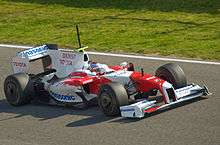
In 2002 Toyota started racing in Formula One with Toyota Motorsport GmbH, based in Cologne, Germany. Although the team scored a point in their first race in Australia, the first two seasons delivered multiple retirements and poor finishes. In 2004, designer Mike Gascoyne was hired to improve results, following previous experience at Jordan and Renault. Under Gascoyne Toyota gained fourth place in the constructors championship in 2005, scoring 88 points and five podium finishes - in what was to be the team's best Formula One season.[9]
However, due to a "fundamental difference of opinion with regard to the technical operations",[10] he was released from his contract in April in the 2006 season. Replaced by Pascal Vasselon, the teams competitiveness fell, and Toyota did not achieve another podium position until 2008. Toyota began supplying customer engines in 2005, initially with Jordan Grand Prix, and continuing as the team was brought and renamed as Midland F1 and Spyker respectively. In 2007, Toyota began supplying engines to the Williams F1 team, in return for providing a drive for Kazuki Nakajima.
After an upbeat in form in 2008, and signing Jarno Trulli and Timo Glock as a replacement for Ralf Schumacher, Toyota scored its first podium since 2006. With the rule changes in the 2009 Formula One Season, the sport's previous winning teams, Ferrari, McLaren, and Renault, had a poor start to the season, and Toyota joined Brawn GP with the "double diffuser" design,[11] making the TF109 one of the fastest teams in the opening races. After scoring three third places, and qualifying one-two at the Bahrain Grand Prix,[12] performance fell rapidly as other teams out-developed the Toyota. A late season improvement in form managed two second places, including Toyota's home race in Japan, and secured fifth position.
Despite the recent improvement in results, Toyota announced on 4 November its withdrawal from Formula One. Akio Toyoda announced that Toyota would be stopping both the team and the engine deal with Williams, citing the economic environment as the main deciding factor.[13] Despite having one of the sports largest budgets,[14] Toyota did not manage to win a Formula One race.
Deutsche Rennsport Meisterschaft
IMSA GT
In the 1980s, Toyota participated in the IMSA GT Championship, using a Toyota Celica in the GTU class. Later Toyota partnered with All American Racers team and moved to the GTP class with sports prototypes such as the Toyota Eagle Mark III, winning the 1992 and 1993 Drivers and Manufacturers titles. Toyota and Lexus Powered Prototypes had also taken Top honors in Grand-Am and 24 Hours of Daytona race.
TC 2000

In 2000 Toyota started racing in TC2000, using a Toyota Corolla. In 2002 Norberto Fontana won the TC2000 championship with a Toyota Corolla.
See also
References
Websites
- "GrandPrix.com GP Encyclopedia Toyota Motorsport". GrandPrix.com. Retrieved 2008-02-19.
- "Official Toyota Racing Site".
- "Toyota Motorsport GmbH website".
Citations
- ↑ "Toyota team pick up a one-year ban". The Independent. London. 1995-11-04. Retrieved 21 March 2009.
- ↑ Toyota Super 2000 Corolla debut
- ↑ Autosport. 2012-01-24 http://www.autosport.com/news/report.php/id/97163. Missing or empty
|title=(help) - ↑ Busch puts Toyota in Sprint Cup victory lane at Atlanta - Sprint Cup Series - Scenedaily.com
- ↑
- ↑
- ↑
- ↑
- ↑ "2005 Constructors Championship results". Formula1.com. Formula One Administration Ltd. Retrieved 2011-01-28.
- ↑ "Gascoyne leaves Toyota 'amicably'". BBC News. British Broadcasting Corporation. 2006-04-06. Retrieved 2011-01-28.
- ↑ "Protests lodged against three teams". ITV-F1.com. ITV. 2009-03-26. Retrieved 2011-01-28.
- ↑ "Trulli leads an all-Toyota front row in Bahrain". Formula1.com. Formula One Administration Ltd. 2009-04-25. Retrieved 2011-01-28.
- ↑ "Toyota announce Formula One withdrawal". Formula1.com. Formula One Administration Ltd. 2009-11-04. Retrieved 2011-01-28.
- ↑ "Toyota predict massive progress". BBC Sport. British Broadcasting Corporation. 2005-01-08. Retrieved 2011-01-28.
External links
| Wikimedia Commons has media related to Toyota in motorsport. |